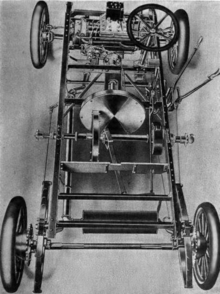
A friction drive [1][2]or friction engine is a type of transmission that utilises the static friction of two smooth surfaces (instead of contact pressure of meshing teeth) to transfer torque between two rotating parts.
This type of mechanism is also called a traction drive, although this term often refers specifically to drives where a layer of traction fluid (that becomes momentarily solid under pressure) is used to increase the friction coefficient between the two parts, to 0.1 or more.[3][4][5]
In general, least one of the two parts is rigid, and it may be any solid of revolution, such as a disk, cylinder, or cone. While the bulk of the rigid part(s) may be constructed of any hard material, such as metal or plastic, at least one of the surfaces where they come into contact usually is coated with some high-friction material, such as hard rubber (or, in early systems, paper or leather).
The most common example of friction drive is a pulley and (smooth) belt pair. However, the name "friction drive" is more often used when both parts are rigid.
- ^ Definition of "friction drive" in the Merriam-Webster Dictionary online. Accessed on 2024007-30.
- ^ Edward I. Fox (1970): "Friction drive mechanism". US Patent 3,487,705. Issued 1970-01-06, expired 1987-01-06.
- ^ John Pawloski (2019): "Traction Drive Technology". Online article by Rolling Motion Industries, at the Midé blog site. Archived on 2024-07-30.
- ^ Santolubes (2024): "SantoTrac Traction Lubricants" Product page at the Santolubes company website. Archived on 2024-07-30.
- ^ Orbital Traction (2023): "Elastohydrodynamic Traction Fluid". At the orbital Traction company website. Archived on 2024-07-30.